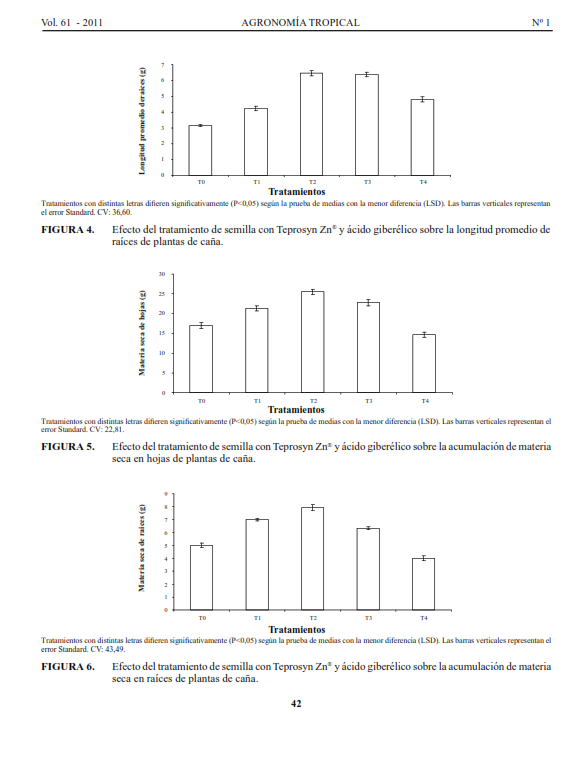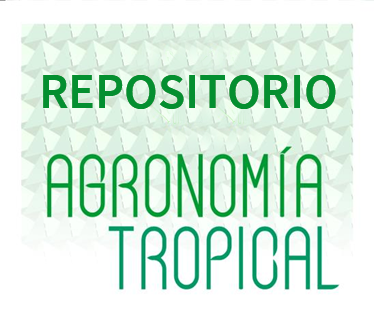Efecto del tratamiento de semilla con zinc y ácido giberélico sobre la emergencia y el crecimiento inicial de las plantas de caña de azúcar
Resumen
Con la finalidad de comparar la aplicación de una suspensión concentrada a base de zinc (Zn), Teprosyn Zn®, con el uso de ácido giberélico (Ág ) en el tratamiento de semilla y evaluar su efecto sobre emergencia y crecimiento inicial de plantas de caña de azúcar, Saccharum spp., var. cp 742005, se condujo un ensayo en la Fundación Azucarera para el Desarrollo, la productividad y la Investigación (FUNDACAÑA), ubicada en Chivacoa, municipio Bruzual, estado Yaracuy. Para tal fin se utilizó un diseño completamente aleatorizado con cinco tratamientos y tres repeticiones, donde el primero de ellos correspondió al testigo sin aplicación (T0). los tratamientos T1, T2 y T3 consistieron en sumergir secciones de tallo de 5 cm de longitud con una yema viable (mini esquejes) por 10 min en soluciones de Teprosyn Zn® al 1%, 2% y 3%, respectivamente, mientras que en el último tratamiento (T4) la semilla se sometió a inmersión en una solución de 1 g Activol® 100 l agua-1 durante el mismo tiempo. la siembra se realizó en bolsas plásticas negras, utilizando un sustrato obtenido a través de una mezcla de suelo y compost de cachaza en una proporción 1:1. los datos fueron analizados con el programa Statistix 8. Los resultados indican que el tratamiento de semilla con Teprosyn Zn® promovió la emergencia, el crecimiento inicial de raíces, el peso aéreo seco y la producción de materia seca (MS) total de las plantas, favoreciendo el establecimiento del cultivo. la utilización de Ág afectó la longitud total de raíces
Descargas
Citas
• Anderson, D. l. y J. E. Bowen. 2000. Nutrición de la caña de azúcar. Instituto de la potasa y el fósforo (INpoFoS). Casilla postal 17-17-980. Quito, Ecuador. 40 p.
• Ashraf, M. and M. R. Foolad. 2005. Presowing seed treatment a shotgun approach to improve germination, plant growth, and crop yield under saline and non-saline conditions. Adv Agron 88:223-271.
• CakmakI., H. Marschner and F. Bangerth. 1989. Effect la utilización de Ág en su dosis única (9,2 mg of zinc nutritional status on growth, protein meta- bolism and levels of indole-3-acetic acid and other
• Akihiko, I., U. Kana, S. Yuichi, N. Yoshitaka and A. Shoichiro. 2006. Effect of zinc and auxin on the formation of adventitious roots and its growth in rice plants. Bulletin of the Faculty of Agriculture, University of Miyazaki. 52(1-2):57-64.
• Alloway, B. J. 2008. Zinc in soils and crop nutrition. 2nd Ed. International Zinc Association (IZA) and International Fertilizer Industry Association (IFA). Brussels, Belgium and Paris, France. 135 p.
• Cakmak, I., I. Tolay, A. Ozdemir, H. Ozkan, l. Ozturk and C. I. Kling. 1999. Differences in zinc efficiency among and within diploid, tetraploid and hexaploid wheat. Ann. Bot. 84:163-171.
• Campanoni, P. and P. Nick. 2005. Auxin-dependent cell division and cell elongation. 1-naphthaleneacetic acid and 2,4-dihclorophenoxyacetic acid activate different pathways. Plant Physiol 137(3):939-948.
• Chao, W. S., M. E. Foley, D. P. Horvath and J. V. Anderson. 2007. Signals regulating dormancy in vegetative buds. Int. J. Plant Devel. Biol. 1(1):49-56.
• Chen, D., T. A. Gunawardena, B. P. Naidu, S. Fukai and J. Basnayake. 2005. Seed treatment with gibberellic acid and glycinebetaine improves seedling emergence and seedling vigor of rice under low temperatures. Seed Sci. Technol. 33(2):471-479.
• Fondo Nacional de Investigaciones Agropecuarias. 1985. El cultivo de la caña de azúcar. FoNAIAp, Yaritagua, Venezuela. 226 p.
• Gebaüer L., J. M. 2009. Efecto de la aplicación de Teprosyn Zn® sobre la germinación y enraizamiento de esquejes de la caña de azúcar (Saccharum sp.) en el proceso de la producción de plántulas de la Agro- pecuaria El Retorno, c. A. en el municipio Esteller, estado portuguesa. Tesis de grado para optar al título de Ing. Agr°. Tarabana, estado Lara. Universidad Centro Occidental Lisandro Alvarado. Decanato de Agronomía, núcleo “Héctor ochoa Zuleta”. 53 p.
• Gonçalves-Martins, M. B. E P. R. de Camargo e castro. 1999. Efeitos de giberelina e ethephon na anatomia de plantas de cana-de-açucar. Pesq. Agropec. Bras. 34(10):1 855-1 863.
• Graham, R. D., J. S. Ascher and S. C. Hynes. 1992. Selecting zinc-efficient cereal genotypes for soils of low zinc status. Plant and Soil 146:241-250.
• Grewal, H. S. and R. D. Graham. 1997. Seed zinc content influences early vegetative growth and zinc uptake in oilseed rape (Brassica juncea) genotypes on zinc-deficient soil. Plant and Soil 192:191-197.
• Grewal, H. S., l. Zhonggu and R. D. graham. 1997. Influence of subsoil zinc on dry matter production, seed yield and distribution of zinc in oilseed rape genotypes differing in zinc efficiency. Plant and Soil192:181-189.
• Harris, D., A. Rashid, G. Miraj, M. Arif and M. Yunas. 2008. ‘On-farm’ seed priming with zinc in chickpea and wheat in Pakistan. plant and Soil 306:3-10.
• Inada, S. and T. Shimmen. 2000. Regulation of elongation growth by gibberellin in root segments of Lemna minor. Plant Cell Physiol. 41(8):932-939.
• Inada, S., M. Tominaga and T. Shimmen. 2000. Regulation of root growth by gibberellin in lemna minor. Plant Cell Physiol. 41(6):657-665. Irvine, J. E. 2004. Sugarcane agronomy. In: glyn James (ed.) Sugarcane. 2nd Ed. Blackwell publishing, oxford. UK. 143-159 pp.
• Kirkby, E. A. and V. Römheld. 2007. Micronutrients in plant physiology: functions, uptake and mobility. proceedings 543. The International Fertilizer Society. York, United Kingdom. 1-51 pp.
• Leyser, O. 1999. Plant hormones: ins and outs of auxin transport. Current Biology 9:8-10.
• Marschner, H. 1995. Mineral nutrition of higher plants. 2nd ed. Academic Press, New York.
• Miller, J. D. and R. A. Gilbert. 2009. Sugarcane botany: A brief view. Document SS-AgR-234. University of Florida. IFAS Extension: 1-6.
• Mutasa-Göttgens, E. and P. Hedden. 2009. Gibberellin as a factor in floral regulatory networks. J. Exp. Bot. 60(5):1 523-1 532.
• Ozdener, Y. and B. K. Aydin. 2009. The effect of zinc on the growth and physiological and biochemical parameters in seedlings of Eruca sativa (l.) (Rocket). Acta Physiol. plant. 32(3):469-476.
• Rai, R. K., P. Singh, A. K. Shrivastava and A. Suman. 2008. Modulation of low-temperature-induced biochemical changes in bud and root band zone of sugar cane sets by potassium, zinc, and ethrel for improving sprouting. J. Agric. Food Chem. 56(24):11 976-11 982.
• Rengel, M., F. Gil y J. Montaño. 2011. Crecimiento y dinámica de acumulación de nutrientes en caña de azúcar. II. micronutrientes. 23(2). Disponible en: https://bit.ly/39qmTo6
• Rengel, Z. and R. D. Graham. 1995. Importance of seed content for wheat growth on Zn-deficient soil. I. Vegetative growth. plant and Soil 173:259-266.
• Richards, D. E., K. E. King, T. Aitali and N. P. Harberd. 2001. How gibberellin regulates plant growth and development: a molecular genetic analysis of gibberellin signaling. Ann. Rev. Plant Physiol. Plant Mol. Biol. 52:67-88.
• Rico, M. I., J. M. Álvarez and J. Novillo. 1995. Mobility and extractability of zinc in soil columns amended with micronutrient formulations. Comm. Soil Sci. Plant Anal. 26 (17 and 18):2 843-2 855.
• Singh, B., S. K. Natesan, B. K. Singh and K. Usha. 2005. Improving zinc efficiency of cereals under zinc deficiency. Current Science 88(1):36-44.
• Singh, I., R. K. Rai, S. Solomon and A. K. Shrivastava. 2003. Role of indole-3-acetic acid in sprouting of subterranean buds in winter initiated sugarcane ratoon. Sugar Tech. 5(3):181-183.
• Sun, T. and F. Gubler. 2004. Molecular mechanism of gibberellin signaling in plants. Ann. Rev. plant Biol. 55:197-223.
• Taiz, l. and E. Zeiger. 2002. Plant physiology. 3rd ed. Sinauer Associates Inc. Sunderland, MA. U.S.A. 881-942 pp.
• Takkar, P. N. and C. D. Walker. 1993. The distribution and correction of zinc deficiency. In: A. D. Robson (ed.) zinc in soils and plants. Kluwer Academic publ., Dordrecht. The Netherlands. 151-166 pp.
• Tanimoto, E. 2005. Regulation of root growth by plant hormones-roles for auxin and gibberellin. crit. Rev. Plant Sci. 24(4):249-265.
• Yilmaz, A., H. Ekiz, B. Torun, I. Gultekin, S. Karanlik, S. A. Bagci and I. Cakmak. 1997. Effect of different zinc application methods on grain yield and zinc concentration in wheat cultivars grown on zinc-deficient calcareous soils. J. Plant Nutr. 20(4-5):461-471.





